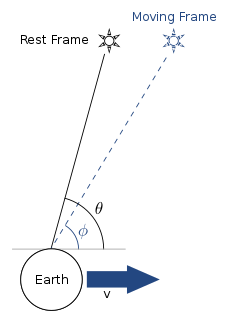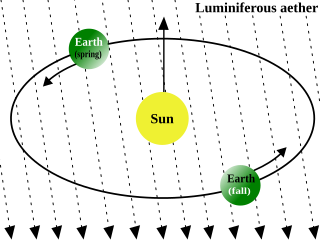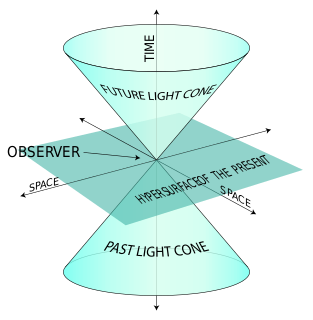Related Research Articles

In astronomy, aberration is a phenomenon which produces an apparent motion of celestial objects about their true positions, dependent on the velocity of the observer. It causes objects to appear to be displaced towards the direction of motion of the observer compared to when the observer is stationary. The change in angle is of the order of v/c where c is the speed of light and v the velocity of the observer. In the case of "stellar" or "annual" aberration, the apparent position of a star to an observer on Earth varies periodically over the course of a year as the Earth's velocity changes as it revolves around the Sun, by a maximum angle of approximately 20 arcseconds in right ascension or declination.

Luminiferous aether or ether was the postulated medium for the propagation of light. It was invoked to explain the ability of the apparently wave-based light to propagate through empty space, something that waves should not be able to do. The assumption of a spatial plenum of luminiferous aether, rather than a spatial vacuum, provided the theoretical medium that was required by wave theories of light.

In physics, special relativity is the generally accepted and experimentally confirmed physical theory regarding the relationship between space and time. In Albert Einstein's original pedagogical treatment, it is based on two postulates:
- the laws of physics are invariant in all inertial frames of reference ; and
- the speed of light in a vacuum is the same for all observers, regardless of the motion of the light source or observer.

In physics, spacetime is any mathematical model which fuses the three dimensions of space and the one dimension of time into a single four-dimensional manifold. Spacetime diagrams can be used to visualize relativistic effects, such as why different observers perceive where and when events occur differently.

The theory of relativity usually encompasses two interrelated theories by Albert Einstein: special relativity and general relativity. Special relativity applies to all physical phenomena in the absence of gravity. General relativity explains the law of gravitation and its relation to other forces of nature. It applies to the cosmological and astrophysical realm, including astronomy.

The Michelson–Morley experiment was an attempt to detect the existence of the luminiferous aether, a supposed medium permeating space that was thought to be the carrier of light waves. The experiment was performed between April and July 1887 by Albert A. Michelson and Edward W. Morley at what is now Case Western Reserve University in Cleveland, Ohio, and published in November of the same year. It compared the speed of light in perpendicular directions in an attempt to detect the relative motion of matter through the stationary luminiferous aether. The result was negative, in that Michelson and Morley found no significant difference between the speed of light in the direction of movement through the presumed aether, and the speed at right angles. This result is generally considered to be the first strong evidence against the then-prevalent aether theory, and initiated a line of research that eventually led to special relativity, which rules out a stationary aether. Of this experiment, Einstein wrote, "If the Michelson–Morley experiment had not brought us into serious embarrassment, no one would have regarded the relativity theory as a (halfway) redemption."

Absolute space and time is a concept in physics and philosophy about the properties of the universe. In physics, absolute space and time may be a preferred frame.
The timeline of luminiferous aether or ether as a medium for propagating electromagnetic radiation begins in the 18th century. The aether was assumed to exist for much of the 19th century—until the Michelson–Morley experiment returned its famous null result. Further experiments were in general agreement with Michelson and Morley's result. By the 1920s, most scientists rejected the aether's existence.

General relativity is a theory of gravitation that was developed by Albert Einstein between 1907 and 1915. According to general relativity, the observed gravitational effect between masses results from their warping of spacetime.
Special relativity is a physical theory that plays a fundamental role in the description of all physical phenomena, as long as gravitation is not significant. Many experiments played an important role in its development and justification. The strength of the theory lies in its unique ability to correctly predict to high precision the outcome of an extremely diverse range of experiments. Repeats of many of those experiments are still being conducted with steadily increased precision, with modern experiments focusing on effects such as at the Planck scale and in the neutrino sector. Their results are consistent with the predictions of special relativity. Collections of various tests were given by Jakob Laub, Zhang, Mattingly, Clifford Will, and Roberts/Schleif.

The Sagnac effect, also called Sagnac interference, named after French physicist Georges Sagnac, is a phenomenon encountered in interferometry that is elicited by rotation. The Sagnac effect manifests itself in a setup called a ring interferometer. A beam of light is split and the two beams are made to follow the same path but in opposite directions. On return to the point of entry the two light beams are allowed to exit the ring and undergo interference. The relative phases of the two exiting beams, and thus the position of the interference fringes, are shifted according to the angular velocity of the apparatus. In other words, when the interferometer is at rest with respect to a nonrotating frame, the light takes the same amount of time to traverse the ring in either direction. However, when the interferometer system is spun, one beam of light has a longer path to travel than the other in order to complete one circuit of the mechanical frame, and so takes longer, resulting in a phase difference between the two beams. This arrangement is also called a Sagnac interferometer. Georges Sagnac set up this experiment to prove the existence of the aether that Einstein's theory of special relativity had discarded.
In the 19th century, the theory of the luminiferous aether as the hypothetical medium for the propagation of light was widely discussed. An important part of this discussion was the question concerning the state of motion of Earth with respect to this medium. The aether drag hypothesis dealt with the question of whether or not the luminiferous aether is dragged by or entrained within moving matter. According to the first variant no relative motion exists between Earth and aether; according to the second one, relative motion exists and thus the speed of light should depend on the speed of this motion, which should be measurable by instruments at rest on Earth's surface. Specific aether models were invented by Augustin-Jean Fresnel who in 1818 proposed that the aether is partially entrained by matter. The other one was proposed by George Stokes in 1845, in which the aether is completely entrained within or in the vicinity of matter.
The history of special relativity consists of many theoretical results and empirical findings obtained by Albert A. Michelson, Hendrik Lorentz, Henri Poincaré and others. It culminated in the theory of special relativity proposed by Albert Einstein and subsequent work of Max Planck, Hermann Minkowski and others.
In physics, aether theories propose the existence of a medium, a space-filling substance or field, thought to be necessary as a transmission medium for the propagation of electromagnetic or gravitational forces. Since the development of special relativity, theories using a substantial aether fell out of use in modern physics, and are now joined by more abstract models.
What is now often called Lorentz ether theory (LET) has its roots in Hendrik Lorentz's "theory of electrons", which was the final point in the development of the classical aether theories at the end of the 19th and at the beginning of the 20th century.
In theoretical physics a Coriolis field is one of the apparent gravitational fields felt by a rotating or forcibly-accelerated body, together with the centrifugal field and the Euler field.
In theoretical physics, a preferred or privileged frame is usually a special hypothetical frame of reference in which the laws of physics might appear to be identifiably different (simpler) from those in other frames.
The Trouton–Rankine experiment was an experiment designed to measure if the Lorentz–FitzGerald contraction of an object according to one frame produced a measurable effect in the rest frame of the object, so that the ether would act as a "preferred frame". The experiment was first performed by Frederick Thomas Trouton and Alexander Oliver Rankine in 1908.
Georges Sagnac was a French physicist who lent his name to the Sagnac effect, a phenomenon which is at the basis of interferometers and ring laser gyroscopes developed since the 1970s.

The Fizeau experiment was carried out by Hippolyte Fizeau in 1851 to measure the relative speeds of light in moving water. Fizeau used a special interferometer arrangement to measure the effect of movement of a medium upon the speed of light.
References
- R.W. Ditchburn, Light, (3rd ed.), Vol.2 (Academic Press, London, 1976) - light and the motion of particulate media
- Kip Thorne, Black holes and timewarps: Einstein's outrageous legacy (Norton, New York, 1995) - frame-dragging around black holes